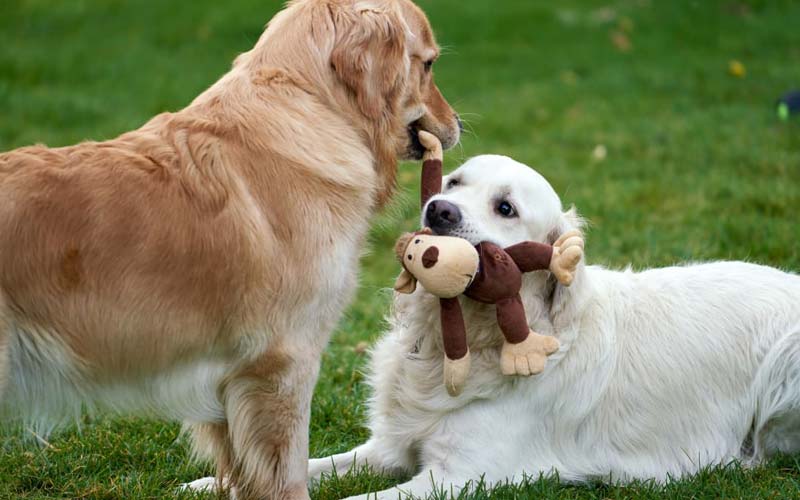Choosing between a male or female dog is a common decision faced by prospective dog owners. Many people wonder whether one gender is naturally better behaved than the other. While general traits are often associated with male and female dogs—such as male dogs being more playful or female dogs being easier to train—the reality is more nuanced. Behavior is shaped by a range of factors beyond gender, including breed, training, and individual personality.

This article explores the typical behavioral differences between male and female dogs, dispelling myths and offering practical advice to help you determine which might be the better fit for your lifestyle. By understanding how various factors influence behavior, you’ll be better equipped to make an informed choice when welcoming a new dog into your home.
1. Understanding Dog Behavior: Nature vs. Nurture
When it comes to understanding dog behavior, the debate between nature and nurture is key. While gender can influence certain traits, a dog’s behavior is shaped more significantly by its genetics, training, and environment.
Genetics plays a foundational role in a dog’s temperament. Breed-specific traits, such as energy levels, sociability, or protective instincts, often have a stronger impact on behavior than gender. For example, a male Border Collie and a female Border Collie will both show high energy and herding instincts, regardless of their sex. Similarly, a breed known for its calm demeanor, like a Basset Hound, will typically exhibit laid-back behavior whether male or female.
Training is one of the most powerful influences on a dog’s behavior. Regardless of gender, a well-trained dog will behave better than one that lacks guidance. Dogs that are properly socialized and receive consistent training tend to be more obedient and less prone to undesirable habits. This highlights the importance of an owner’s role in shaping their dog’s behavior.
Environment also plays a crucial role. The way a dog is raised, its daily routines, and how it’s treated can shape its behavior over time. A nurturing, structured environment leads to a well-adjusted dog, whether male or female. Dogs that grow up in a stable, loving home with clear boundaries tend to display fewer behavioral issues compared to those in chaotic or neglectful situations.
In the end, while gender may introduce slight behavioral tendencies, factors such as breed, upbringing, and the effort put into training and socialization will have a much greater impact on how a dog behaves. Choosing between a male or female dog should be based more on the specific needs of the dog and the owner’s ability to meet those needs, rather than gender alone.

2. General Behavioral Traits of Male Dogs
Male dogs are often associated with specific behavioral traits that can influence how they interact with people and other animals. While individual temperament varies, there are some general tendencies commonly observed in male dogs.
Playfulness and Energy Levels
Male dogs, especially when young, are typically more active and playful compared to females. They tend to enjoy physical activity and are often eager to engage in games like fetch, running, or roughhousing. This high energy level can make male dogs great companions for families or individuals who lead active lifestyles. However, this playfulness can sometimes translate into restlessness if they don’t get enough exercise or mental stimulation, potentially leading to undesirable behaviors like chewing or digging.
Territorial Marking and Independence
One of the more notable traits in male dogs, especially unneutered ones, is their tendency to mark territory. Male dogs often use urination as a way to claim their space, particularly when they are in unfamiliar environments or around other dogs. This behavior is driven by their natural instinct to assert dominance and establish their presence. In addition, male dogs may display a greater level of independence. They often enjoy exploring their surroundings on their own and may not always seek constant attention from their owners.
Dominance and Maturity
Unneutered male dogs are more likely to exhibit dominance-related behaviors, such as mounting or challenging other dogs. This can sometimes lead to issues with aggression or competitiveness, especially around other unneutered males. It’s also worth noting that male dogs tend to mature more slowly than females. This slower maturity can make them seem more stubborn or distracted during training in their early years. However, with consistent training and socialization, many of these behaviors can be managed effectively.
While male dogs can be playful, independent, and sometimes dominant, their behavior largely depends on factors like neutering, training, and environment. Understanding these general traits can help potential owners decide whether a male dog is the right fit for their lifestyle.

3. General Behavioral Traits of Female Dogs
Female dogs, much like their male counterparts, exhibit certain general behavioral traits that can influence how they interact with their owners and environment. While each dog’s personality is unique, some common tendencies are seen in female dogs, especially regarding maturity, affection, and hormonal changes.
Early Maturity
One of the key traits of female dogs is that they tend to mature faster than males. This early maturity can make them more focused and responsive during training at a younger age. As a result, many owners find female dogs easier to train, particularly in the early stages of development. Their quicker emotional and mental growth often leads to more predictable behavior, making them a good fit for owners who prefer a more stable, trainable companion.
Affection and Nurturing
Female dogs are often considered more affectionate and nurturing, especially after being spayed. While males can be just as loving, females typically seek out more physical closeness and are thought to form deeper emotional bonds with their families. This nurturing side of female dogs may make them ideal companions for families with children or owners who enjoy a more attentive, affectionate pet. It’s important to note, however, that this tendency can vary based on the individual dog’s personality.
Mood Swings and Hormonal Changes
For unspayed females, mood swings are more common, particularly during their heat cycles. These hormonal changes can lead to fluctuations in behavior, with some dogs becoming more irritable, restless, or clingy. During this time, they may also show a desire to roam in search of a mate, which can result in unpredictable behavior if they aren’t kept in a secure environment. Spaying, however, significantly reduces these issues, leading to a more consistent temperament.
While female dogs may mature faster, display nurturing behaviors, and experience hormonal changes, much of their behavior depends on factors like training, spaying, and individual personality. These traits can make them appealing to owners looking for a trainable and affectionate companion, but it’s important to consider the unique needs and tendencies of each dog.

4. The Role of Spaying and Neutering in Behavior
Spaying and neutering are common procedures that can have a significant impact on a dog’s behavior, particularly in managing hormonal influences. For both male and female dogs, these surgeries can lead to a range of positive behavioral changes, making them more consistent and manageable as pets.
Impact of Neutering on Male Behavior
Neutering male dogs often leads to a marked reduction in certain behaviors tied to testosterone. One of the most noticeable changes is a decrease in aggression. Unneutered males are more prone to aggressive behaviors, particularly toward other males, as they compete for dominance or attention. Neutering lowers testosterone levels, making them less likely to engage in such confrontations.
Another common issue with unneutered males is territorial marking. Male dogs often mark their territory by urinating in various places, particularly in new environments or around other dogs. Neutering reduces this urge, making them less likely to mark excessively, which is a benefit for indoor living.
Additionally, neutered males tend to have improved focus and trainability. Without the distraction of mating instincts, they can concentrate better on commands and tasks, making training sessions more productive and leading to better long-term behavior management.
Impact of Spaying on Female Behavior
Spaying female dogs has its own set of behavioral benefits. One of the most significant changes is the reduction of mood swings that can occur during their heat cycles. Unspayed females often experience hormonal fluctuations that can lead to irritability, anxiety, or clinginess during their heat. Spaying removes these hormonal shifts, creating a more stable temperament.
Another key benefit is a decreased desire to roam. Female dogs in heat often try to escape or roam in search of a mate, which can be stressful for owners and dangerous for the dog. Spaying eliminates this drive, reducing the risk of wandering and making them more content to stay within familiar boundaries.
Finally, spayed females typically develop a more consistent behavior pattern. Without the hormonal influences of their reproductive cycle, they tend to be calmer, more predictable, and easier to manage in day-to-day life.
Overall, spaying and neutering can significantly improve a dog’s behavior by reducing hormonal urges that lead to aggression, marking, mood swings, or roaming. This makes them more adaptable to household life and more focused on their training and relationship with their owners.

5. Key Considerations for Dog Owners
When deciding between a male or female dog, several key factors should be considered to ensure a good match for both the dog and the household. Understanding lifestyle fit, training considerations, and family dynamics can help prospective dog owners make an informed choice that suits their specific needs.
Lifestyle Fit
One of the most critical aspects to evaluate is how a dog’s energy levels, independence, and affection preferences align with the family’s lifestyle.
- Active Families: If you lead an active lifestyle, a male dog may be a better fit, as they are generally more playful and energetic, particularly in their younger years. Males often thrive in environments where they can engage in regular physical activities, such as running or hiking, and require ample stimulation to prevent boredom.
- Laid-Back Households: For families that prefer a more relaxed environment, a female dog may be a suitable choice. With their typically calmer demeanor, spayed females can offer a nurturing presence without the high energy levels often seen in males. They tend to adapt well to a quieter home, making them ideal companions for those who enjoy a more sedentary lifestyle.
Understanding how much time and energy you can dedicate to a dog is crucial. Both genders require exercise and mental stimulation, but their behavioral tendencies can help guide your choice based on how active or relaxed your home life is.
Training Considerations
Training plays a significant role in a dog’s overall behavior, and some may wonder whether males or females are easier to train. Generally, female dogs tend to mature faster, which can lead to quicker learning and responsiveness during training sessions. They often display a higher willingness to please, making them more amenable to commands and structure.
On the other hand, unneutered male dogs may present more challenges during training due to their higher energy levels and potential distractions from mating instincts. However, with consistent training, patience, and clear guidance, both male and female dogs can become well-trained companions. Ultimately, an individual dog’s personality and the owner’s commitment to training will significantly influence success.
Family Dynamics
When considering a new dog, it’s essential to think about family dynamics and how a dog of either gender will fit into your home.
- Homes with Children: Families with young children may find that female dogs often have a nurturing and gentle demeanor, making them more suitable for households with kids. However, many male dogs are also excellent with children, especially if they have been properly trained and socialized.
- Other Pets: If you have other pets, the dynamics can also play a role in your decision. Male dogs may display more territorial behaviors, which could lead to conflicts with existing pets. Conversely, females are often more adaptable and may integrate more smoothly into a multi-pet household.
- Living Conditions: Consider your living environment when selecting a gender. For instance, if you live in a small apartment, a calmer female dog may be easier to manage in confined spaces. On the other hand, if you have a large yard or access to open areas, a more energetic male may thrive in that setting.
By considering these key factors—lifestyle fit, training needs, and family dynamics—prospective dog owners can make a more informed decision about whether a male or female dog is the best match for their home. Each dog is an individual, and understanding how their traits align with your lifestyle is crucial for a successful and fulfilling companionship.

6. Debunking Myths About Male and Female Dogs
As potential dog owners navigate the decision between male and female dogs, several myths and misconceptions can cloud their judgment. It’s essential to address these myths to provide a clearer understanding of canine behavior and help owners make informed choices based on facts rather than stereotypes.
Male Dogs Are Always More Aggressive
One of the most pervasive myths is that male dogs are inherently more aggressive than females. While it is true that unneutered males may exhibit more dominant and territorial behaviors, aggression is not a universal trait among male dogs. Many male dogs are gentle, affectionate, and well-behaved, especially when neutered. Factors such as breed, training, and socialization play a far more significant role in a dog’s temperament than gender alone. Proper training and socialization can lead to a well-adjusted male dog, regardless of his natural inclinations.
Female Dogs Are Always More Nurturing
Another common misconception is that female dogs are automatically more nurturing and affectionate than their male counterparts. While many people associate femininity with nurturing behavior, this isn’t universally true. Just as there are nurturing male dogs, some female dogs may be aloof or independent. Individual personality varies widely among dogs, and many males can form deep, loving bonds with their families, often displaying affection and loyalty equal to or surpassing that of females.
Spaying and Neutering Remove All Behavior Issues
A related myth is that spaying or neutering will resolve all behavioral problems. While these procedures can significantly reduce issues tied to hormones, such as aggression and marking, they are not a catch-all solution. Behavioral issues can stem from a variety of factors, including inadequate training, lack of socialization, or underlying health problems. Owners must be proactive in providing consistent training and a supportive environment to nurture their dog’s well-being.
One Gender Is Better for Families Than the Other
Some prospective owners believe that one gender is universally better suited for families with children. While female dogs are often perceived as more nurturing, this doesn’t mean male dogs can’t be equally affectionate and gentle with kids. Each dog has a unique temperament, and many male dogs are known for their patience and playfulness, making them fantastic companions for children.
Ultimately, the behavior and temperament of a dog are influenced far more by individual personality, training, and socialization than by gender. It’s crucial for potential dog owners to look beyond stereotypes and consider each dog as an individual. By focusing on the dog’s unique characteristics and ensuring proper training and socialization, owners can foster a loving and well-adjusted companion, regardless of whether they choose a male or female dog.

7. Expert Opinions and Studies
Understanding gender differences in dog behavior has been a subject of interest for many researchers and dog behaviorists. While personal experiences may vary, several studies and expert opinions provide insight into the nuances of male and female canine behavior, lending authority to the ongoing discussion.
One study published in the Journal of Veterinary Behavior found that while there are observable trends in behavior between male and female dogs, the differences are often overstated. The study noted, “Gender may influence certain behavioral traits, but the individual dog’s environment, training, and socialization play a far more critical role in shaping behavior.” This reinforces the idea that while there are general trends, individual personality is paramount.
Veterinarians often weigh in on this topic as well. Dr. Julie Buzby, a veterinarian and founder of ToeGrips, states, “While many people believe that male dogs are more aggressive, it’s important to remember that aggression can stem from a variety of factors including fear, lack of training, and poor socialization. Neutering can help reduce some of these behaviors, but every dog is an individual.” Her perspective highlights the importance of addressing behavioral issues with comprehensive training rather than relying solely on gender-based assumptions.
Similarly, renowned dog behaviorist and trainer Patricia McConnell emphasizes the need for understanding the individual dog rather than making broad generalizations based on gender. She asserts, “Each dog is shaped by their experiences and upbringing. While there may be trends associated with gender, it’s the individual dog’s life history and personality that truly matter.”
Additionally, a survey conducted by the American Kennel Club (AKC) revealed that most owners perceive their dogs as unique individuals, regardless of gender. According to the survey, “A majority of dog owners believe that personality traits, rather than gender, are the best indicators of a dog’s behavior.”
These expert opinions and research findings underscore the complexity of dog behavior and the need to consider multiple factors beyond gender when evaluating a dog’s temperament. By focusing on the individual dog’s experiences and training, owners can foster positive behaviors and create strong, lasting bonds with their canine companions.

8. Real-Life Examples from Dog Owners
Real-life experiences from dog owners provide valuable insights into the behavioral differences between male and female dogs. These anecdotes highlight that individual personality traits often play a more significant role than gender alone in shaping a dog’s behavior.
The Energetic Male vs. the Calm Female
Jessica, a dog owner from Denver, shares her experience with her two dogs: Max, a male Labrador Retriever, and Bella, a female Golden Retriever. “Max is full of energy. He needs to run every day and loves to play fetch for hours. He can be a bit of a handful, especially when he’s not exercised enough,” she explains. In contrast, Bella, although also active, tends to enjoy quieter activities like cuddling on the couch. “She’s more laid-back and loves to just hang out with us, which balances things out nicely.”
Jessica emphasizes that while both dogs are friendly and well-behaved, their individual personalities shine through, showcasing how two dogs of different genders can have distinctly different energy levels and preferences.
The Affectionate Male
Another dog owner, Tom, recounts his journey with two male dogs: Charlie, an unneutered Boxer, and Buddy, a neutered Beagle. Initially, Tom was concerned about Charlie’s potential for aggression, as he had heard Boxers could be territorial. However, he found that Charlie was affectionate and playful, especially around children. “Charlie loves to cuddle and is very gentle, even with little kids. I’ve never seen aggressive behavior from him at all,” Tom shares. On the other hand, Buddy, while also friendly, has a different temperament. “Buddy is a bit more independent and sometimes likes to do his own thing. He’ll snuggle up when he wants affection but isn’t as needy as Charlie.”
Tom’s experience underscores that even within the same gender, behavior can vary greatly based on individual personality traits, training, and upbringing.
A Family with Both Genders
Samantha and her family have both a female and a male dog: Daisy, a spayed Border Collie, and Finn, a neutered Australian Shepherd. She reflects on their differences: “Daisy is super smart and picks up commands quickly, but she can be moody, especially if she’s tired. Finn, on the other hand, can be a little slow to learn commands, but he’s incredibly eager to please and is always up for playtime.”
Samantha highlights that while Daisy tends to be more nurturing and protective of her children, Finn’s playful nature makes him a favorite for family activities. This showcases how both dogs contribute positively to the family dynamic despite their different genders and personalities.
These anecdotes illustrate that the behavior of dogs cannot be generalized solely by gender. Instead, each dog’s individual traits, experiences, and training significantly influence how they behave and interact with their owners and environment. Such real-life examples reinforce the idea that prospective dog owners should focus on the specific dog’s personality rather than adhering to stereotypes about male and female dogs.

Conclusion: Are male or female dogs better behaved?
Choosing between a male or female dog involves understanding various factors beyond simple gender stereotypes. While there are general trends in behavior associated with each gender, individual personality, training, and socialization play crucial roles in shaping a dog’s temperament.
Throughout this article, we’ve explored key considerations for dog owners, including the influence of spaying and neutering on behavior, the impact of lifestyle fit on choosing the right companion, and the importance of family dynamics. We also debunked common myths surrounding male and female dogs and highlighted expert opinions that emphasize the individuality of each dog. Real-life examples from dog owners further illustrate that personality traits can vary significantly even within the same gender.
As you consider bringing a dog into your home, remember to focus on the individual dog’s characteristics, ensuring a good match for your family’s lifestyle and dynamics. Whether you choose a male or female, the most important factors are training, socialization, and nurturing a loving bond.
Take Action: If you’re contemplating adding a furry friend to your family, do your research, visit shelters, and interact with different dogs. Assess their personalities and consider how they will fit into your life. The right dog for you may come in any gender, but the best fit will always be one that matches your family’s unique needs and lifestyle. Embrace the journey of finding your perfect companion, and you’ll be rewarded with years of love and joy.